1. Introduction
The population’s diet has changed over the years, which has led to an increase in the consumption of plant-based foods in Western countries [1,2,3,4].
A vegetarian is defined as a person who does not consume any type of meat, including poultry, seafood, fish, or products containing them. However, within vegetarianism, there are different groups, some less restrictive than others. From less restrictive to more restrictive, we find the ovolactovegetarians who do include dairy products and eggs in their diet, the lactovegetarians who only include milk, and the vegans who do not include any type of food of animal origin [5,6,7] .
The reason why people choose to consume such foods varies greatly depending on their age:
- -
- Adolescents for reasons of animal or environmental concern.
- -
- Adults who wish to improve their health.
Historically, this type of food is related to health, culture, and religious factors [8,9]. The origin of this diet is found in ethical–religious and medical movements, since it was used as a ritual of health and purity of the body. For example, in China, a large part of the population continues to maintain a vegetarian diet and it is also in traditional Russian medicine, in India meat is not consumed because it is considered an act of violence, and in the Buddhist religion, meat consumption was not introduced until the end of the Second World War [10].
However, in Europe, vegetarianism began in the Renaissance, and from that moment, began to expand. It was in 1847 when a group of vegetarians met and formed the first vegetarian society in Europe, which was named “Vegetarian Society” [10].
The benefits of this diet, as evidenced by the American Dietetic Association, are an improvement in health and in the prevention and treatment of pathologies. It has been shown that the chances of developing cardiovascular pathologies are lower, while some cancers have shown improvements in the biochemical parameters of the organism. It should be noted that vegetarians are not only characterized by their eating style, but also by generally engaging in more physical activity and consuming less harmful products [11].
However, this diet not only has the benefits outlined above, but it also has some negative aspects. The main disadvantage is the possibility of suffering from nutritional deficiencies, especially in vitamin B12, zinc, iron, calcium, omega-3 fatty acids, and protein [7,11].
To ascertain the effects that this diet may have on sports performance, we need to compare the nutritional contributions of the foods that make up the vegetarian diet with that of the omnivorous diet.
According to The Academy of Nutrition and Dietetics, a well-planned vegetarian diet can meet the macronutrient and energy needs of an athlete [12,13]. Vegetarian diets can vary widely in terms of calorie content and fiber, just like omnivorous diets. It is important for vegetarian athletes to focus on a balanced and nutrient-rich diet that supports their performance and overall health. As for the carbohydrate requirements of sportsmen and sportswomen, mainly in endurance sports, athletes need to replenish their glycogen stores, as the success of their sports performance will depend on this. This is why carbohydrate intake recommendations are between 3 and 12 g/kg/day depending on the volume, intensity, and type of exercise effort [11]. Vegetarian diets do not meet the daily protein recommendation, but it should be kept in mind that, in the case of athletes, the requirements are higher, and these depend on the sports: 1–1.6 g/kg in endurance sports and 1.4–2 g/kg for strength athletes [11,14]. It has been shown that people who follow a vegetarian diet can cover their protein requirements of high biological value if they consume eggs and dairy products, as well as legumes and nuts. With respect to fats, the requirement for athletes is like that of non-athletes (20–35% of total daily calories), and these should be healthy fats [11].
When planning a diet for an athlete, the total energy requirement must be taken into account, along with the basal metabolism, the energy expenditure generated by the physical exercise performed, and the thermogenic effect of food, which represents between 3% and 10% of the total energy expenditure [15]. Some of the methods used to calculate it are the equations, such as Harris–Benedict or Mifflin–St-Jeor, using electronic devices such as watches or cell phones, or direct and indirect calorimetry.
Hydration is a key factor in successful performance, as it optimizes thermoregulation during exercise [16]. Correct fluid levels should be monitored before, during, and after exercise. Ideally, fluid loss should not exceed 2%, as higher values decrease cognitive function and performance. Athletes can lose between 0.3 and 2.4 liters of body fluid per hour of exercise through sweat, depending on variables, such as environment, gender, body size, and exercise duration [15].
We must also take into account the intake of micronutrients, which, according to several studies, is deficient when a vegetarian diet is followed [17]. The main mineral that research should be focused on is iron. The type of iron suitable for vegetarians is non-heme iron, and the amount that is absorbed will depend on whether it is consumed with enhancers (vitamin C and citric acid) or inhibitors. Iron is important in an athlete’s performance as it is involved in the delivery of oxygen to the muscle. According to Fuhrman and Ferreri (2010), it is not necessary to take supplements if an adequate amount of food containing this mineral is consumed, except in cases of anemia, low ferritin, or menorrhagia. Something similar happens with zinc, which is consumed in foods that contain a large amount of this micronutrient, although such foods also inhibit its absorption. Supplementation is recommended due to its importance in the functioning of the immune system function [18]. These studies have linked vegetarian diets with vitamin B12 deficiency, which is associated with cardiovascular pathologies [18]. These same authors mention the importance of an adequate supply of vitamin D in athletes, since it is directly related to the musculoskeletal system, and the best sources of vitamin D are sun exposure and/or the consumption of fortified foods.
Injured athletes should control caloric intake to lose as little muscle mass as possible during the period when there is the least amount of movement. During this period, athletes should increase protein intake by 1.2–1.5 g/kg to aid healing tissue formation while reducing muscle loss [15].
In terms of performance in strength and endurance sports, it can be stated that the vegetarian diet provides the necessary nutrients for good performance, provided that the diet is well planned. In strength sports, protein intake is especially relevant, although with the intake of plant proteins, such as legumes, seeds, nuts, and whole grains, the recommendations can be met [5]. In addition, there are now a large number of foods enriched with micro-nutrients, which can help vegetarian or vegan athletes reach the recommended intakes.
Some of the athletes, both strength and endurance, who eat a vegetarian or vegan diet are Derek Tresize and Carla Lewis, bodybuilder and velocity athlete [19], respectively, as well as in intermittent sports, such as soccer or tennis, as we find in the cases of Saul Ñiguez and Novak Djokovic.
This review aims to assess the effects of vegetarian and omnivorous diets on various aspects of athletic performance, health-related parameters, and nutritional intake.
2. Materials and Methods
2.1. Acquisition of Evidence
For this systematic review, we followed the protocol according to the standards and guidelines of the PRISMA statement for systematic reviews and meta-analyses, which aims to improve the reporting of future systematic reviews [20].
2.2. Eligibility Criteria
We included articles that met the following inclusion criteria: (a) publications in the last ten years (from 2013 to 2023); (b) written in English or Spanish; (c) clinical trials and randomized controlled clinical trials using a placebo or control group; (d) relationship between diet and sports performance; (e) women of working age (intervention group performing a physiotherapeutic intervention; (f) cytokine analysis. Exclusion criteria were (i) animals were used for research. (ii) clinical trials without results or not completed. (iii) literature reviews.
2.3. Sources of Information
The literature search was conducted between September 2022 and September 2023. The aim of the search was to find out whether athletic performance changed as a function of the diet the athlete would take. The databases used were Web Of Science (WOS), PubMed, Cochrane, and Dialnet.
2.4. Search Strategies
The keywords we used for the document search were “vegetarian diet”, “vegan diet”, “performance”, “sport”, and “exercise”. The search strategy was (“vegetarian diet” OR “vegan diet”) AND (performance OR sport OR exercise). At the end of the search, we had 263 articles that met the search criteria, after reading the abstracts, methods, and objectives, exclusion criteria were applied:
- -
- Articles with a publication date prior to 2013.
- -
- Articles that were written in a language other than English or Spanish.
- -
- Articles in which animals were used for research.
- -
- Articles that were literature reviews.
- -
- Articles that did not link diet to sports performance.
2.5. Data Extraction Process
An exhaustive reading and evaluation of the six studies finally selected were carried out, to which the PEDro scale was applied to assess their methodological quality, evaluating the design of the study, the source of obtaining the subjects, whether the study was randomized, whether there was concealment, whether there was blinding, and what the outcome of the study was like. The PEDro scale of the synthesis results can be found in more detail in Section 3.5.
In addition, the PRISMA 2020 checklist [20] was used to collect the most relevant data for each of the studies, author and year, type of study, sample characteristics, objectives, type of intervention, intervention time, diet, ergogenic aids, program, healthy variables, and performance variables. Figure 1 shows the process followed in selecting the articles used for the literature review according to PRISMA declaration. The results of the data extraction will be presented in .
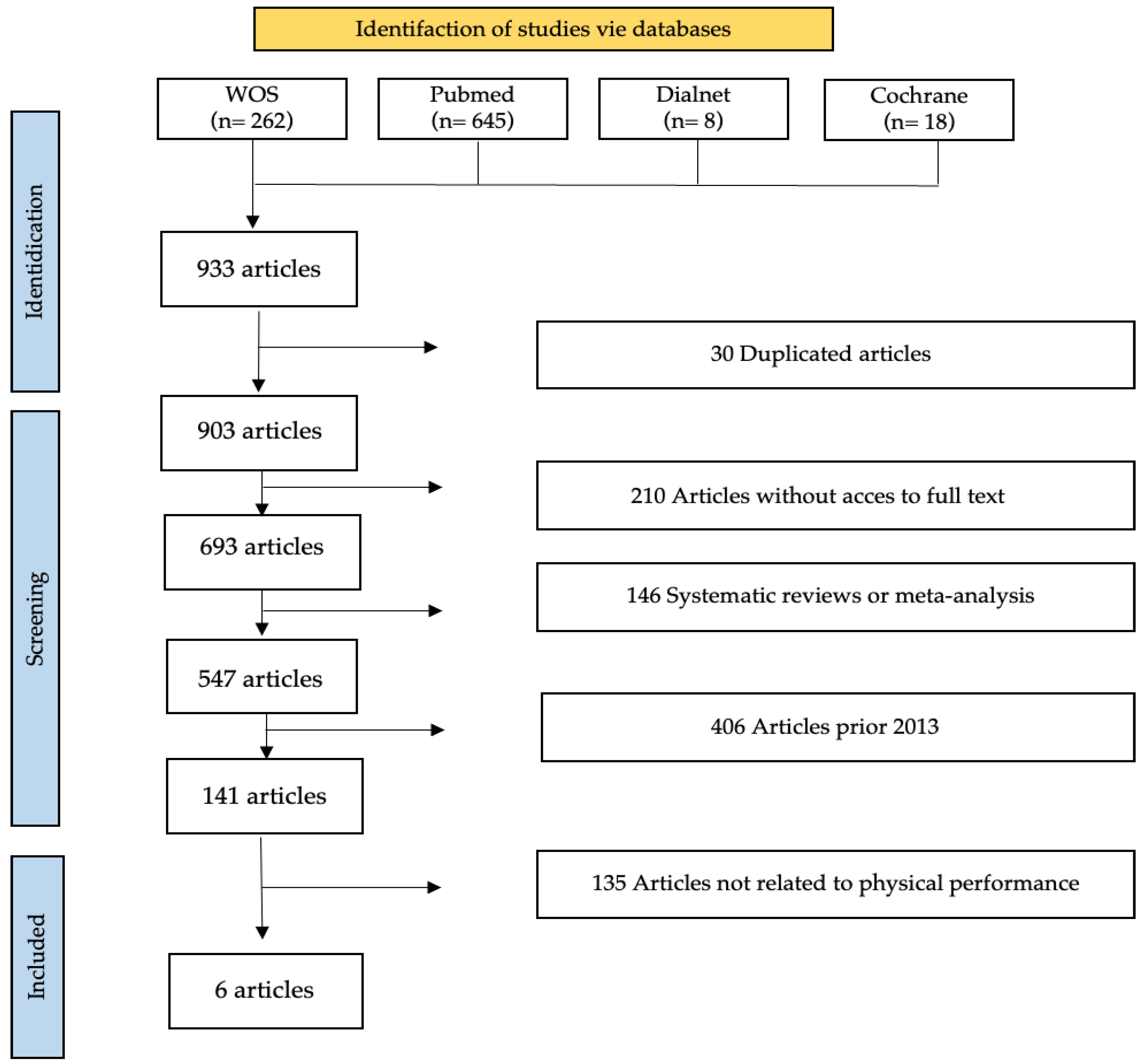
Figure 1. Flow diagram according to the PRISMA declaration.
2.6. Risk of Bias Assessment of Individual Studies
Risk of bias is a tool developed by the Cochrane Collaboration to assess the methodology of scientific evidence. It is useful in systematic reviews for the individual analysis of included CTs and RCTs. In this sense, the present systematic review has followed the Cochrane Handbook 5.1.0 [21] to assess the risk of bias.
The Cochrane Handbook 5.1.0 presents six levels of bias: selection bias, conduct bias, detection bias, attrition bias, reporting bias, and other bias. Each level has one or more specific items in a Risk of Bias table, and each item includes a description of what happened in the study and an assessment where the assignment of “low risk”, “high risk”, or “unclear risk” of bias is included [21].
2.7. Synthesis Methods
The synthesis methods used in the present review are the eligibility criteria that were determined in Section 2.2 of Material and Methods and the analysis of methodological quality using the PEDro scale, which is based on the Delphi checklist developed by Verhagen [22]. The checklist has a total of 11 items. The first item refers to external validity and is not considered for the final score, items 2–9 refer to internal validity, and items 10 and 11 indicate whether the statistical information provided by the authors allows for an adequate interpretation of the results.
Therefore, the maximum score is 10 points, and the minimum is 0. Only items that are answered affirmatively are scored. Studies with a score of 9–10 were of excellent methodological quality, 6–8 were of good quality, and 5 were of fair or acceptable quality. The PEDro scale can be found in more detail in Section 3.5.
Further to the synthesis measures, we assessed whether the studies included in the analysis met their objectives set at the start of the study.
2.8. List of Variables
details the study variables found in the articles found for this systematic review.
3. Results
3.1. Selection of Studies
During the initial phase of the search, 933 studies were identified from different databases. After eliminating duplicates, 903 studies remained.
To refine the selection, we applied date filters (2013–2023) and chose to select only clinical trials and randomized clinical trials, which were available in English or Spanish, leaving us with 141 articles. After reviewing the titles and abstracts, 135 studies that did not fit the study topic were discarded. After a detailed reading, a total of six studies that met the inclusion criteria were selected and subjected to a qualitative analysis, using database filters for date and type of study. Mendeley was used to search for duplicates.
3.2. Characteristics of the Studies
Of the total articles included in this review, 33.33% were published in 2016 [23,24], 16.67% in 2018 [25], 16.67% in 2020 [26], and 33.33% in 2021 [27,28]. A total of 3363 individuals participated, with 1921 females, of whom 543 were vegetarians, 652 vegans, and 726 omnivores; and 1442 males, with 305 vegetarians, 352 vegans, and 785 omnivores.
The articles were cross-sectional studies, trial-control studies, or randomized clinical trials. Of the six studies included in this systematic review, five present a group of athletes eating a vegetarian or vegan diet and a control group composed of athletes eating an omnivorous diet. A single observational study compares subjects according to diet and sport modality, 10 km, half marathon, and marathon. More detailed information can be found in the descriptive table of each of the studies in .
3.3. Results of Individual Studies
The results of the data extraction will be presented in .
3.4. Risk of Bias in Individual Studies
A risk of bias assessment of the individual studies was performed, allowing a more accurate picture of the quality of the available evidence and the reliability of the results obtained.
The risk of bias assessment figures for each study included in this systematic review are shown below. Each figure will show the result of the risk of bias assessment for each domain assessed, allowing us to identify the strengths and weaknesses of each study. In this way, we will gain a more detailed understanding of the quality of the included studies and their impact on the overall results of the systematic review.
In the risk of bias graph (Figure 2), it can be seen that the incomplete short- and long-term outcome data and selective reporting is 100% low risk; while blinding of participants, personal, and outcome assessment is 83.3% low risk; other source of bias is 50% low risk; and randomized sequence generation and allocation concealment is 83.3% high risk.
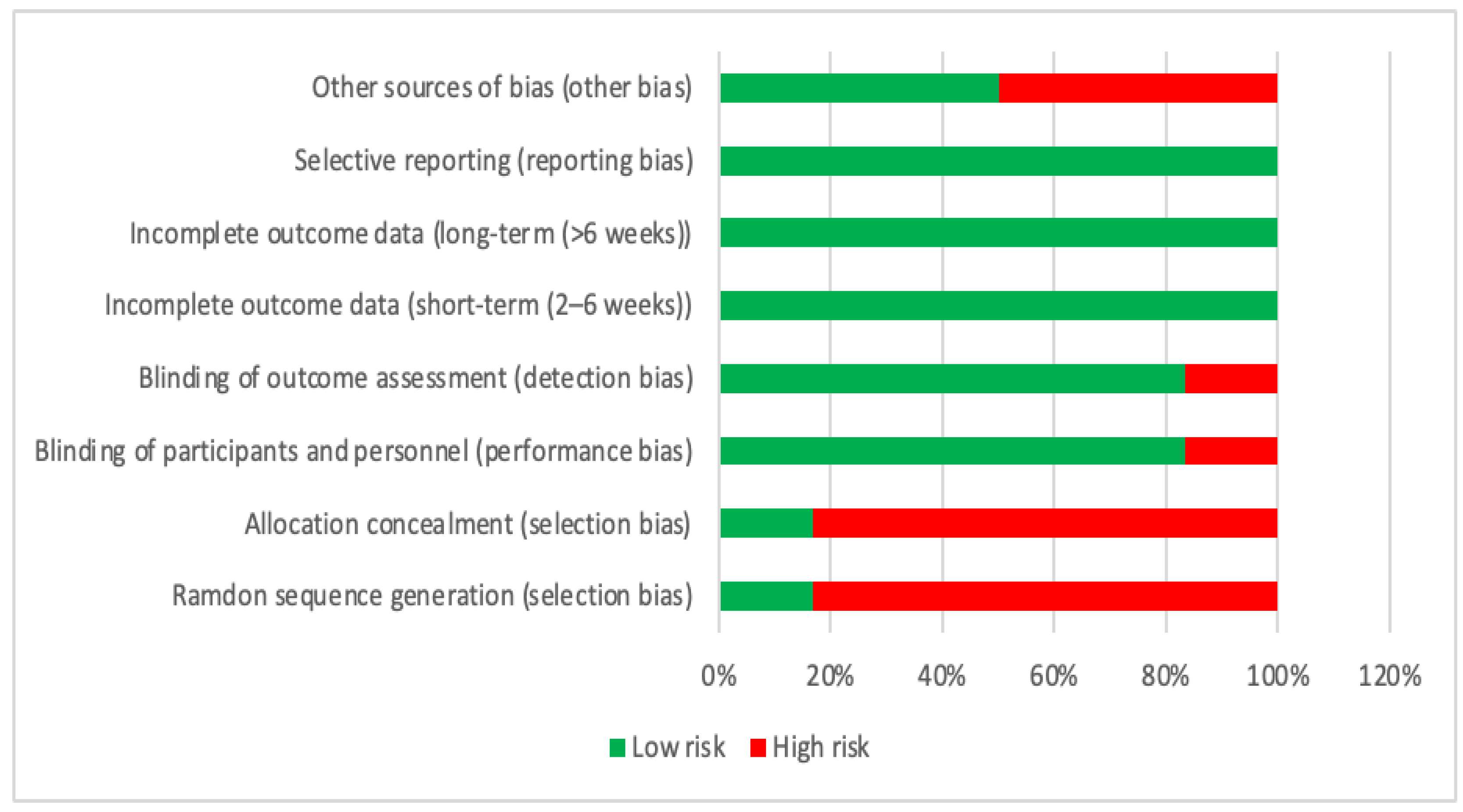
Figure 2. Risk of bias.
In the present review, the articles with the greatest bias are those that are not randomized and that do not blind the group assignment [23,25,26,27,28]. The article with the greatest bias is due to the lack of blinding of the subjects and the evaluators, as well as other biases such as only specifying the depurative modality [25]. In some articles there are other types of biases, such as not specifying exercise variables [27] or that the calculated dietary intake was based on a 3-day recall [25,26].
Furthermore, in the risk of bias summary (Figure 3), it can be seen which author and item has a low risk, unclear risk, and high risk.
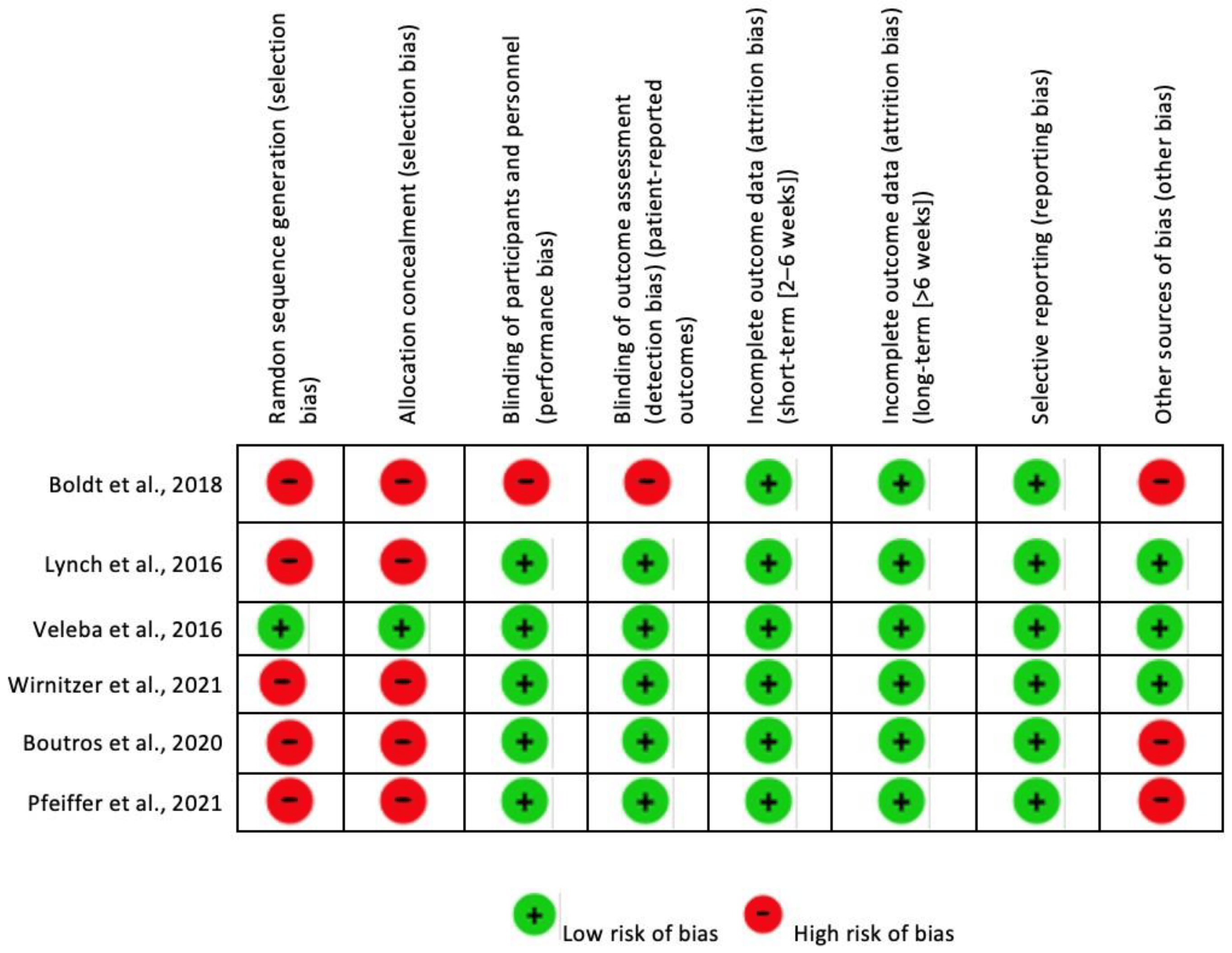
Figure 3. Risk of bias summary [23,24,25,26,27,28].
3.5. Results of the Synthesis
The articles included in the review were assessed using the PEDro methodological quality scale, shown below in . The final score obtained ranged from 5 to 10. Five studies were classified as being of good quality and one of fair quality. The studies achieved a mean value of 6.16 ± 0.75.
4. Discussion
After analyzing the different studies, we observed that the practice of physical exercise and diet must be understood together to perform at one’s maximum. As shown in Figure 4, the percentage of subjects who performed different endurance tests was evaluated as a function of their diet, and it was observed that in the tests of less than 21 km, the vegans were the ones who performed the largest number of tests, both male and female athletes (14% and 10%, respectively); in half marathons, male vegans (32%) and female vegetarians (43%) obtained the greatest percentage; and, finally, in marathon or ultra marathon events, male and female omnivores were the ones who performed the largest number of tests (60% and 37%, respectively) [27].
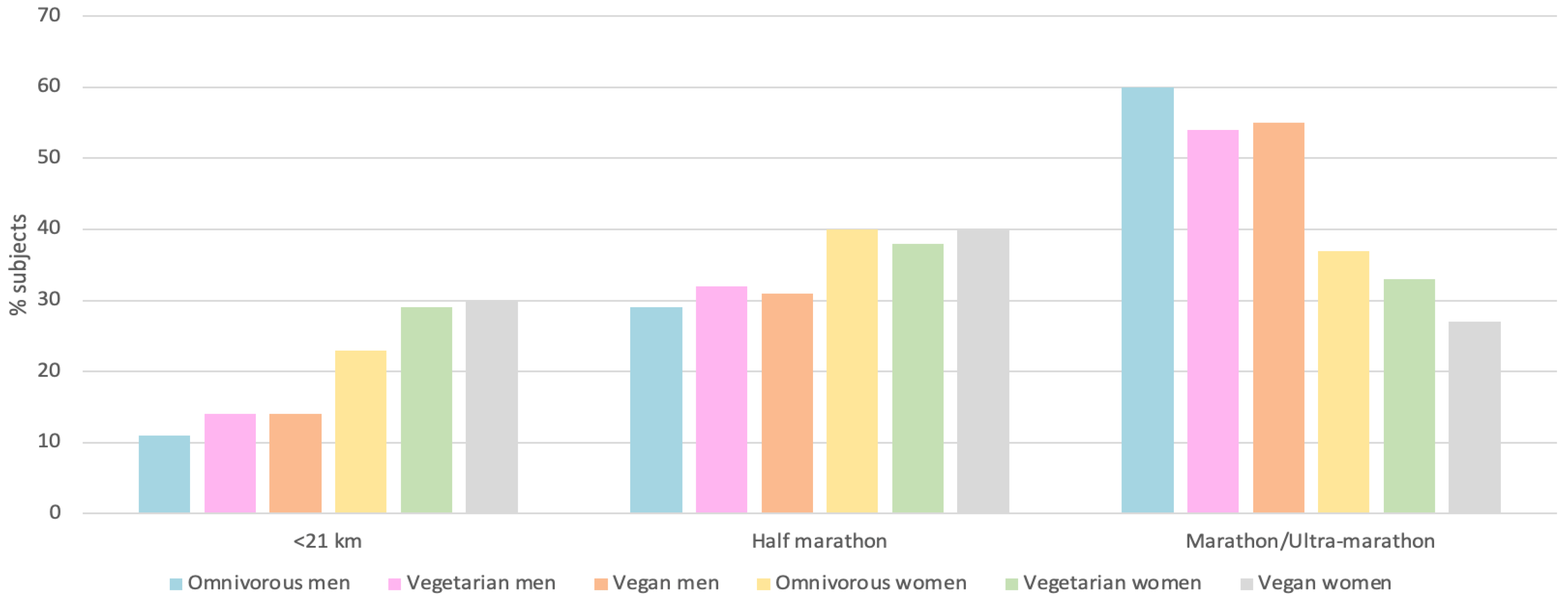
Figure 4. Percent of subjects performing different endurance modalities as a function of diet [27].
4.1. Physical Health
Through the quality-of-life questionnaire (WHOQOL-BREF), there is a difference in some variables related to health depending on diet and type of exercise. The results show that omnivorous women and men have better physical health, but the differences are not significant, so to say that both are adequate to maintain good physical health is not entirely accurate (Figure 5). Physical health is greater in women who run half marathons, followed by those who participate in marathons or ultra marathons, and, finally, those who run 10 km races. However, in men, physical fitness decreases gradually as the distance increases [25].
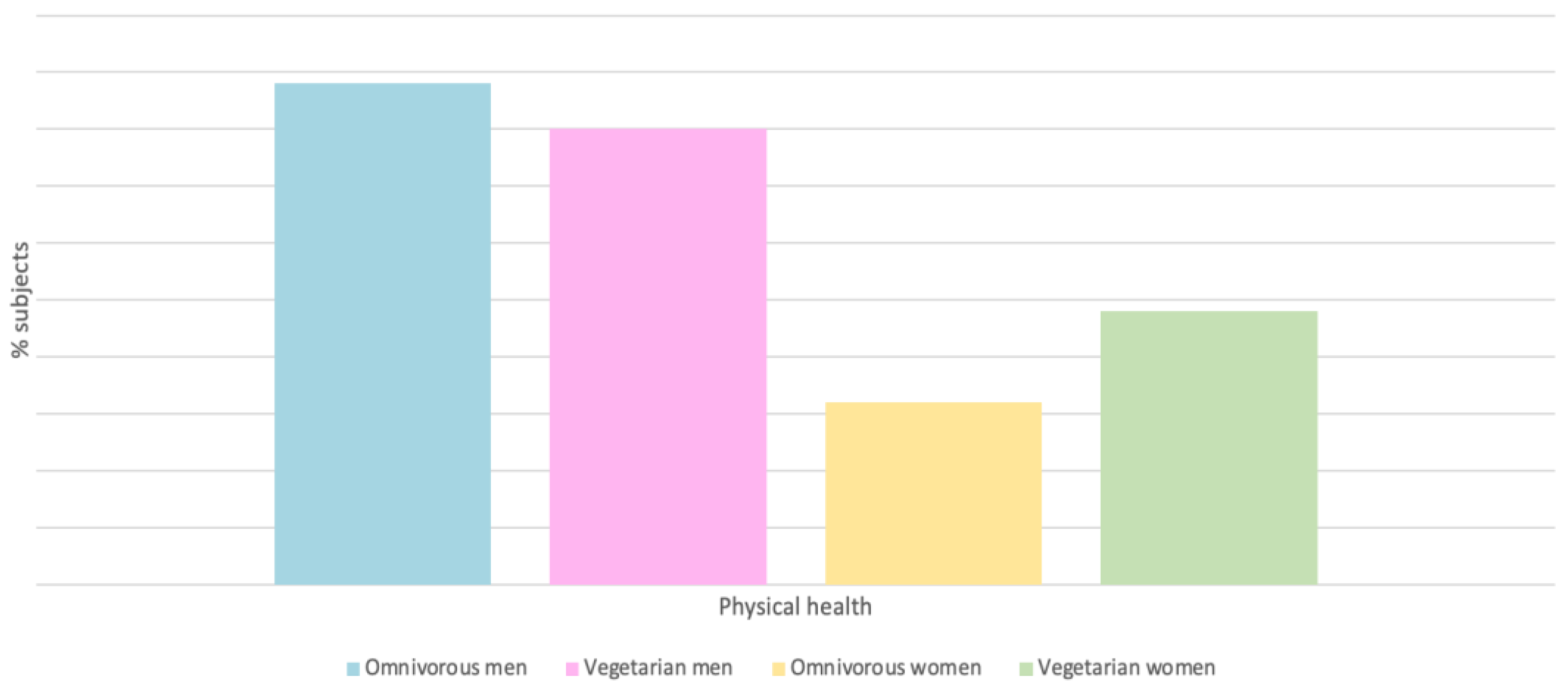
Figure 5. Physical health % of different subjects as a function of diet [25].
Vegetarian diets can help athletes protect themselves from degenerative and inflammatory diseases, as well as improve their body composition [29].
Other parameters related to health in the sports environment have also been studied, such as psychological well-being, the environment, and social relationships were also researched. In relation to psychological well-being and social relationships, athletes with an omnivorous diet report a higher level, although the differences are not significant. Finally, and in relation to the environment, the omnivorous subjects were also those who presented a better adaptation, with significant differences in women according to the sport modality, half marathon, and 10 km races, with the former presenting a greater adaptation to the environment [25].
4.2. Body Composition
Body composition is a factor that is directly related to athletic performance, although there are no ideal values, since they vary depending on the sport (Figure 6) [23].
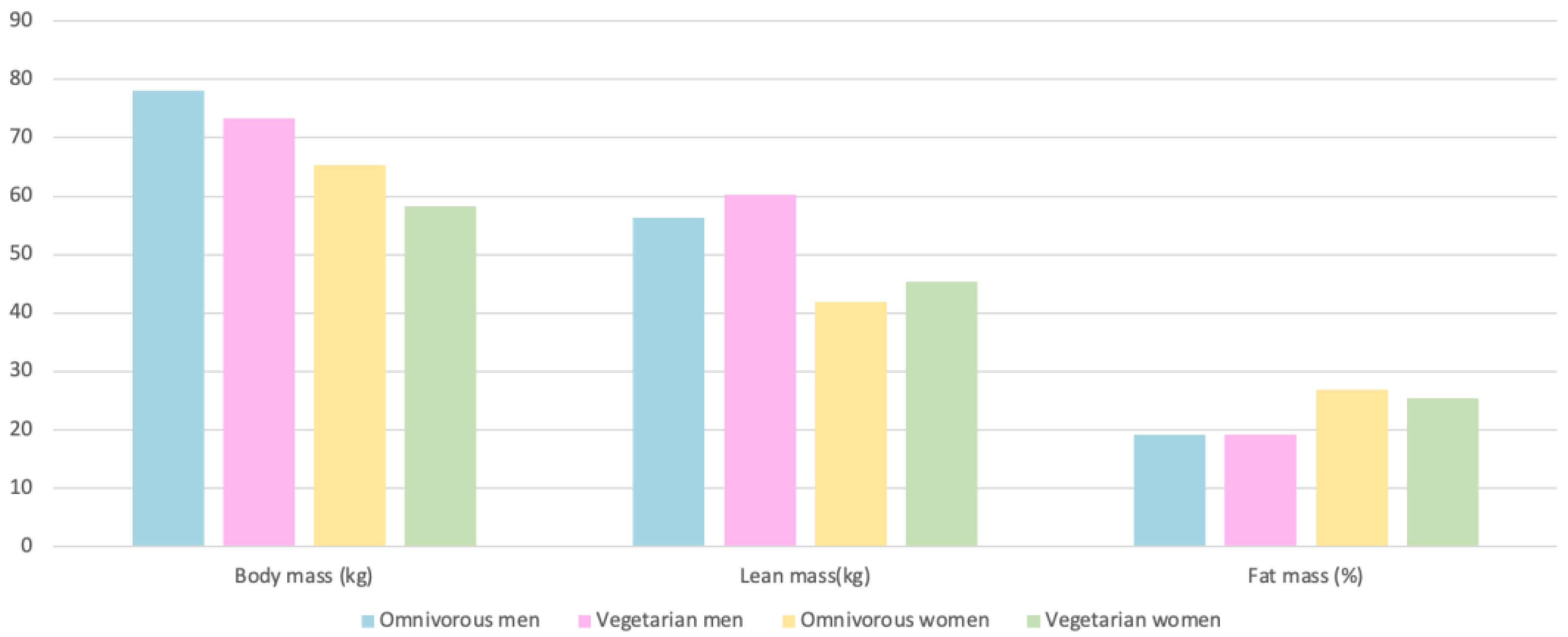
Figure 6. Body composition of subjects according to diet [23].
4.3. Performance
On diet and exercise compliance, vegetarians had a high adherence rate of 55%, while omnivores had an adherence rate of only 32%. Sometimes, this may be because high-performance athletes are hesitant to follow these types of nutritional guidelines that would allow them to achieve the desired performance for competition [24].
4.4. Metabolism
Another variable that was measured and is related to performance is macronutrient oxidation. Although there were no significant differences in fats or proteins, there were differences in carbohydrates, remaining in vegetarians at 0.3 mL/kg/min and decreasing in omnivores from 0.3 mL/kg/min to 0.1 mL/kg/min [24]. Furthermore, there were no significant differences in the respiratory quotient [24].
However, a review of studies comparing athletes on omnivorous or vegetarian diets found that there were no significant differences between the groups, and that the exercise protocols were very different [34].
5. Conclusions
In relation to performance, athletes on a vegetarian diet obtained significantly higher values of relative oxygen consumption and maximum power, compared to omnivores. However, no significant differences were found in strength-related parameters.
Physical fitness was higher in vegetarian women, although no significant differences were shown. Finally, and in relation to dietary intake, vegetarian or vegan athletes consumed significantly more carbohydrates and less protein and saturated fat. Therefore, it is important for athletes to plan a diet that meets their nutritional needs according to the type of sport, as well as the period of the season they are in.
References
- Agnoli, C.; Baroni, L.; Bertini, I.; Ciappellano, S.; Fabbri, A.; Papa, M.; Pellegrini, N.; Sbarbati, R.; Scarino, M.L.; Siani, V.; et al. Position paper on vegetarian diets from the working group of the Italian Society of Human Nutrition. Nutr. Metab. Cardiovasc. Dis. 2017, 27, 1037–1052. [Google Scholar] [CrossRef]
- Kaushik, N.K.; Aggarwal, A.; Singh, M.; Deswal, S.; Kaushik, P. Vegetarian Diets: Health Benefits and Associated Risks. IAIM 2015, 2, 206–210. Available online: http://iaimjournal.com/wp-content/uploads/2015/03/34-Vegetarian-Diets.pdf (accessed on 4 October 2023).
- Lynch, H.; Johnston, C.; Wharton, C. Plant-based diets: Considerations for environmental impact, protein quality, and exercise performance. Nutrients 2018, 10, 1841. [Google Scholar] [CrossRef]
- Craig, W.J. Health effects of vegan diets. Am. J. Clin. Nutr. 2009, 89, 1627S–1633S. [Google Scholar] [CrossRef]
- Rojas Allende, D.; Figueras Díaz, F.; Durán Agüero, S. Ventajas y desventajas nutricionales de ser vegano o vegetariano. Rev. Chil. Nutr. 2017, 44, 218–225. [Google Scholar] [CrossRef]
- Key, T.J.; Appleby, P.N.; Rosell, M.S. Health effects of vegetarian and vegan diets. Proc. Nutr. Society. 2006, 65, 35–41. [Google Scholar] [CrossRef]
- Shaw, K.A.; Zello, G.A.; Rodgers, C.D.; Warkentin, T.D.; Baerwald, A.R.; Chilibeck, P.D. Benefits of a plant-based diet and considerations for the athlete. Eur. J. Appl. Physiol. 2022, 122, 1163–1178. [Google Scholar] [CrossRef]
- Barr, S.I.; Rideout, C.A. Nutritional considerations for vegetarian athletes. Nutrition 2004, 20, 696–703. [Google Scholar] [CrossRef]
- Diets, V. News from the Association. J. Neonatal Nurs. 2009, 15, 189–190. [Google Scholar]
- Saz-Peiró, P.; del Ruste, M.M.; Saz-Tejero, S. La dieta vegetariana y su aplicación terapéutica. Med. Natur. 2013, 7, 13–27. [Google Scholar]
- Torres Flores, F.; Mata Ordóñez, F.; Pavia Rubio, E.; Ríos Quirce, C.; Sánchez-Oliver, A.J. Dieta vegetariana y rendimiento deportivo. EmásF Rev. Digit. De Educ. Física 2017, 46, 27–38. Available online: https://dialnet.unirioja.es/descarga/articulo/5963359.pdf (accessed on 4 October 2023).
- Thomas, D.T.; Erdman, K.A.; Burke, L.M. Position of the Academy of Nutrition and Dietetics, Dietitians of Canada, and the American College of Sports Medicine: Nutrition and Athletic Performance. J. Acad. Nutr. Diet. 2016, 116, 501–528. [Google Scholar] [CrossRef]
- Thomas, D.T.; Burke, L.M.; Erdman, K.A. Nutrition and Athletic Performance. Med. Sci. Sports Exerc. 2016, 48, 543–568. [Google Scholar] [PubMed]
- Onzari, M. Introducción a la nutrición deportiva. In Fundamentos de Nutrición en el Deporte, 3rd ed.; El Ateneo: Buenos Aires, Argentina, 2021; pp. 15–27. Available online: https://editorialelateneo.com.ar/descargas/FUND. NUTRICIÓN EN EL DEPORTE (1er cap).pdf (accessed on 4 October 2023).
- Bytomski, J.R. Fueling for Performance. Sports Health 2018, 10, 47–53. [Google Scholar] [CrossRef]
- Herring, S.A.; Ben Kibler, W.; Putukian, M.; Brien, S.O.; York, N.; Jaffe, R.; Wilmington, D.E.; Lori Boyajian-O_Neill, D.O.; Overland Park, K.S.; Vincent Disabella, D.O.; et al. Selected Issues for Nutrition and the Athlete. Med. Sci. Sports Exerc. 2013, 45, 2378–2386. [Google Scholar]
- Nieman, D.C. Physical fitness and vegetarian diets: Is there a relation? Am. J. Clin. Nutr. 1999, 70, 570S–575S. [Google Scholar] [CrossRef]
- Fuhrman, J.; Ferreri, D.M. Fueling the vegetarian (vegan) athlete. Curr. Sports Med. Rep. 2010, 9, 233–241. [Google Scholar] [CrossRef]
- Mayoral, J. La alimentación natural y deporte. Nat. Food Sports 2000, 60, 38–42. Available online: https://dialnet.unirioja.es/descarga/articulo/4989590.pdf (accessed on 4 October 2023).
- Yepes-Nuñez, J.J.; Urrútia, G.; Romero-García, M.; Alonso-Fernández, S. The PRISMA 2020 statement: An updated guideline for reporting systematic reviews. Rev. Esp. Cardiol. 2021, 74, 790–799. [Google Scholar]
- Wolfenden, L.; Barnes, C.; Jones, J.; Finch, M.; Wyse, R.J.; Kingsland, M.; Tzelepis, F.; Wiggers, J.; Williams, A.J.; Seward, K.; et al. Strategies to improve the implementation of healthy eating, physical activity and obesity prevention policies, practices or programmes within childcare services. Cochrane Database Syst. Rev. 2020, 2020, CD011779. [Google Scholar] [CrossRef]
- Verhagen, A.P.; De Vet, H.C.W.; De Bie, R.A.; Kessels, A.G.H.; Boers, M.; Bouter, L.M.; Knipschild, P.G. The Delphi list: A criteria list for quality assessment of randomized clinical trials for conducting systematic reviews developed by Delphi consensus. J. Clin. Epidemiol. 1998, 51, 1235–1241. [Google Scholar] [CrossRef] [PubMed]
- Lynch, H.M.; Wharton, C.M.; Johnston, C.S. Cardiorespiratory fitness and peak torque differences between vegetarian and omnivore endurance athletes: A cross-sectional study. Nutrients 2016, 8, 726. [Google Scholar] [CrossRef] [PubMed]
- Veleba, J.; Matoulek, M.; Hill, M.; Pelikanova, T.; Kahleova, H. A vegetarian vs. conventional hypocaloric diet: The effect on physical fitness in response to aerobic exercise in patients with type 2 diabetes. A parallel randomized study. Nutrients 2016, 8, 671. [Google Scholar] [CrossRef] [PubMed]
- Boldt, P.; Knechtle, B.; Nikolaidis, P.; Lechleitner, C.; Wirnitzer, G.; Leitzmann, C.; Rosemann, T.; Wirnitzer, K. Quality of life of female and male vegetarian and vegan endurance runners compared to omnivores—Results from the NURMI study (step 2). J. Int. Soc. Sports Nutr. 2018, 15, 33. [Google Scholar] [CrossRef]
- Boutros, G.H.; Landry-Duval, M.A.; Garzon, M.; Karelis, A.D. Is a vegan diet detrimental to endurance and muscle strength? Eur. J. Clin. Nutr. 2020, 74, 1550–1555. [Google Scholar] [CrossRef]
- Wirnitzer, K.; Motevalli, M.; Tanous, D.; Wirnitzer, G.; Leitzmann, C.; Wagner, K.H.; Rosemann, T.; Knechtle, B. Training and racing behaviors of omnivorous, vegetarian, and vegan endurance runners—Results from the nurmi study (Step 1). Nutrients 2021, 13, 3521. [Google Scholar] [CrossRef]
- Pfeiffer, A.; Tomazini, F.; Bertuzzi, R.; Lima-Silva, A.E. Sprint Interval Exercise Performance in Vegans. J. Am. Nutr. Assoc. 2022, 41, 399–406. [Google Scholar] [CrossRef]
- Oral, O.; Rezaee, Z.; Nomikos, G.N.; Tatlibal, P. Vegetarian diets and their impact on athletes. Sci. Chron. Epistimonika Chron. 2022, 27, 530–540. [Google Scholar]
- Campbell, W.W.; Barton, M.L.; Cyr-Campbell, D.; Davey, S.L.; Beard, J.L.; Parise, G.; Evans, W.J. Effects of an omnivorous diet compared with a lactoovovegetarian diet on resistance-training-induced changes in body composition and skeletal muscle in older men. Am. J. Clin. Nutr. 1999, 70, 1032–1039. [Google Scholar] [CrossRef]
- Clarys, P.; Deliens, T.; Huybrechts, I.; Deriemaeker, P.; Vanaelst, B.; De Keyzer, W.; Hebbelinck, M.; Mullie, P. Comparison of nutritional quality of the vegan, vegetarian, semi-vegetarian, pesco-vegetarian and omnivorous diet. Nutrients 2014, 6, 1318–1332. [Google Scholar] [CrossRef]
- Pérez, F.J.G.; Vicho, G.B.; Dorado, A.C.; Marín, D.M.; Gil, M.C.R.; Mariño, M.M. Análisis nutricional en atletas de fondo y medio fondo durante una temporada deportiva. Nutr. Hosp. 2016, 33, 1136–1141. [Google Scholar]
- West, S.; Monteyne, A.J.; van der Heijden, I.; Stephens, F.B.; Wall, B.T. Nutritional Considerations for the Vegan Athlete. Adv. Nutr. 2023, 14, 774–795. [Google Scholar] [CrossRef] [PubMed]
- Craddock, J.C.; Probst, Y.C.; Peoples, G.E. Vegetarian and omnivorous nutrition-comparing physical performance. Int. J. Sport Nutr. Exerc. Metab. 2016, 26, 212–220. [Google Scholar] [CrossRef] [PubMed]
- Phillips, S.M.; van Loon, L.J.C. Dietary protein for athletes: From requirements to optimum adaptation. J. Sports Sci. 2011, 29 (Suppl. S1), 37–41. [Google Scholar] [CrossRef] [PubMed]
- Menal-Puey, S.; Morán Del Ruste, M.; Marques-Lopes, I. Nutritional composition of common vegetarian food portions. Nutr. Hosp. 2016, 33, 386–394. [Google Scholar] [CrossRef]
- Ahmed, A.; Afzaal, M.; Ali, S.W.; Muzammil, H.S.; Masood, A.; Saleem, M.A.; Saeed, F.; Hussain, M.; Rasheed, A.; Jbawi, E.A. Effect of vegan diet (VD) on sports performance: A mechanistic review of metabolic cascades. Int. J. Food Prop. 2022, 25, 2022–2043. [Google Scholar] [CrossRef]
- Rogerson, D. Vegan diets: Practical advice for athletes and exercisers. J. Int. Soc. Sports Nutr. 2017, 14, 36. [Google Scholar] [CrossRef]
- Śliż, D.; Parol, D.; Wełnicki, M.; Chomiuk, T.; Grabowska, I.; Dąbrowska, D.; Król, W.; Price, S. Macronutrient intake, carbohydrate metabolism and cholesterol in Polish male amateur athletes on a vegan diet. Nutr. Bull. 2021, 46, 120–127. [Google Scholar] [CrossRef]
- Pohl, A.; Schünemann, F.; Bersiner, K.; Gehlert, S. The impact of vegan and vegetarian diets on physical performance and molecular signaling in skeletal muscle. Nutrients 2021, 13, 3884. [Google Scholar] [CrossRef]
- Page, M.J.; McKenzie, J.E.; Bossuyt, P.M.; Boutron, I.; Hoffmann, T.C.; Mulrow, C.D.; Shamseer, L.; Tetzlaff, J.M.; Akl, E.A.; Brennan, S.E.; et al. The PRISMA 2020 statement: An updated guideline for reporting systematic reviews. BMJ 2021, 372, n1. [Google Scholar] [CrossRef]

